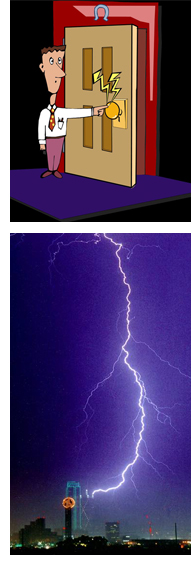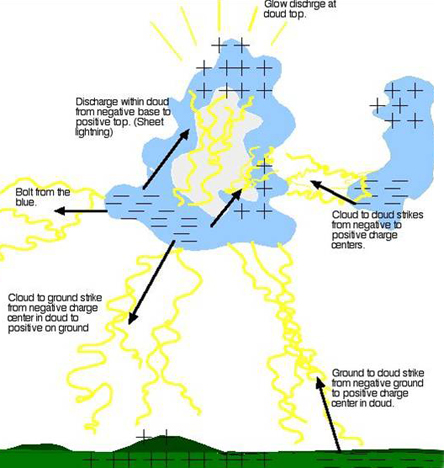|
 Lightning, by definition, is the “discharge of atmospheric electricity from one cloud to another or from a cloud to the earth.” Lightning, by definition, is the “discharge of atmospheric electricity from one cloud to another or from a cloud to the earth.”
When considering lightning, particularly as it relates to Lightning Protection, it is extremely important to keep in mind that this phenomenon is simply a massive spark of discharged electricity. Everyone has had the experience of being “shocked” when you touch a door knob after walking across a carpet. This “shock” is static electricity created by the friction of dissimilar materials rubbing together. In this instance your shoes and the carpet. The same thing happens on a grand scale in a thunderstorm.
In the case of lightning, the friction is between small particles carried in a thunderstorm. Thunderstorms can be localized events or part of a weather system. In either case they are the result of warm and cool air masses colliding. The introduction of cooler air causes the warmer air to rise high up into the atmosphere.
The rising hot air carries moisture high into the atmosphere thus creating the tall clouds associated with thunderstorms. Eventually the warm air climbs so high into the atmosphere that it cools and begins to sink back down. A cycle of rising and falling within the cloud develops. During this up and down process particles within the cloud collide and begin to take on different electrical charges – some positive – some negative. Different sections of the cloud begin to carry particular charges. These opposite charges are attracted to each other but the high resistance of air keeps them apart. The same process that is happening within the cloud is also happening below the cloud. Charged areas develop on the ground. These pockets of oppositely charged particles eventually become strong enough that the differences in charge or potential must release – this release is lightning.
 The drawing shows the many forms that lightning takes. Lightning can also flash within a cloud, between two clouds, from cloud to air, and from cloud to ground. Obviously it is the cloud to ground lightning we are most concerned with. The drawing shows the many forms that lightning takes. Lightning can also flash within a cloud, between two clouds, from cloud to air, and from cloud to ground. Obviously it is the cloud to ground lightning we are most concerned with.
The path that the lightning follows through the air to the ground is called the STEPPED LEADER. The stepped leader is the jagged path that lightning takes as it struggles to move through air. These steps range in length from 30 to 600 feet. Once the lightning has stepped to within a couple hundred feet of the ground, the charges that have built up on the ground begin to come into play. On the ground the charge, in effect, strains upward and gathers on the edges and highest parts of objects such as trees, hills, roof tops, chimneys, flag poles, etc. As the approaching stepped leader nears the ground, the electric fields on ground objects becomes strong enough to produce sparks called counter-leaders, which race upward to meet the descending stepped leader.
When the two meet, a path to ground is established and the main lightning current instantly retraces that same path. This “return stroke” has an enormous amount of power that super heats the surrounding column of air causing it to expand at supersonic speed and creating the sound of thunder.
|